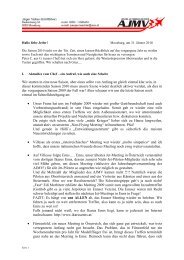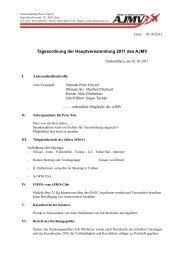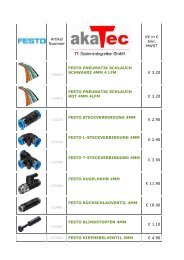A turbofan Viper is coming to replace the rowdy, thirsty ... - AKATEC IT
A turbofan Viper is coming to replace the rowdy, thirsty ... - AKATEC IT
A turbofan Viper is coming to replace the rowdy, thirsty ... - AKATEC IT
Create successful ePaper yourself
Turn your PDF publications into a flip-book with our unique Google optimized e-Paper software.
orne and <strong>the</strong> gear was quickly retracted<br />
<strong>to</strong> avoid overspeeding <strong>the</strong> gear. Th e nose<br />
continued <strong>to</strong> r<strong>is</strong>e, <strong>the</strong> airspeed continued<br />
<strong>to</strong> accelerate, and in moments we<br />
were at 250 KIAS at a ridiculous deck<br />
angle with <strong>the</strong> VSI pegged. In moments<br />
we leveled at 10,500 feet, accelerating in<br />
spite of a healthy power reduction.<br />
I looked at <strong>the</strong> fuel fl ow on takeoff ,<br />
but it was off scale. Leveling at 10,500,<br />
we did a speed run. Burning 240 gph—<br />
again, not a m<strong>is</strong>print—<strong>the</strong> airplane<br />
was accelerating br<strong>is</strong>kly. Th e fl ight-test<br />
program had not exceeded 325 KIAS,<br />
which <strong>is</strong> 420 KTAS, and we reached<br />
that quickly. We <strong>to</strong>ok off with 200 gallons<br />
of fuel on board, so our time fl ying<br />
at that power setting was limited. Pulling<br />
<strong>the</strong> power back <strong>to</strong> a m<strong>is</strong>erly 120 gph<br />
yielded a more reasonable 230 KIAS,<br />
which equated <strong>to</strong> 300 KTAS.<br />
Nature of <strong>the</strong> Pure Jet<br />
Th ese numbers seem ridiculous, and<br />
<strong>the</strong>y are. Pure jet airplanes are intended<br />
<strong>to</strong> climb quickly <strong>to</strong> <strong>the</strong>ir maximum<br />
operating altitude, and <strong>the</strong>y do best<br />
when <strong>the</strong>y can remain <strong>the</strong>re until an<br />
idle thrust descent takes <strong>the</strong>m <strong>to</strong> <strong>the</strong>ir<br />
destination. With <strong>the</strong> pressurization<br />
functioning, <strong>the</strong> airplane would climb<br />
quickly <strong>to</strong> FL270 or FL280, where <strong>the</strong><br />
5.5 psi cabin diff erential would yield a<br />
10,500 foot cabin pressure.<br />
At those fl ight levels <strong>the</strong> <strong>Viper</strong>Jet<br />
folks say <strong>the</strong> airplane will true 320<br />
KTAS, burning 90 gph. Th e J85 or its<br />
CJ-610 cousin would be much happier<br />
at FL390 or even FL410, but reduced<br />
vertical separation minimums (RVSM)<br />
require strict certifi cation and au<strong>to</strong>pilot<br />
requirements, making FL280 <strong>the</strong> practical<br />
ceiling of <strong>the</strong> airplane.<br />
Once it was clear that <strong>the</strong> airplane<br />
would go really fast it was time <strong>to</strong> fi nd<br />
out if <strong>the</strong> airplane would go slow. I <strong>to</strong>ok<br />
<strong>the</strong> stick for some air work. Th e stick<br />
forces were comfortable in pitch and<br />
slightly heavy in roll. Th e rudder forces<br />
are immaterial because without any<br />
<strong>to</strong>rque <strong>the</strong>re <strong>is</strong> little need for rudder.<br />
Th e vertical seems large enough that <strong>the</strong><br />
airplane <strong>is</strong> stable in yaw.<br />
Steep turns are not diffi cult, but<br />
<strong>the</strong> airplane changes altitude so eas-<br />
ily that fl ying <strong>to</strong> check ride standards<br />
requires close attention. Some slick,<br />
fast airplanes have a dark underbelly<br />
that appears at <strong>the</strong> bot<strong>to</strong>m end of <strong>the</strong><br />
airspeed tape. I pulled <strong>the</strong> airplane <strong>to</strong><br />
fl ight idle. Airplanes without propellers<br />
don’t slow down. Th e only way <strong>to</strong> get <strong>the</strong><br />
airplane near its stall speed was <strong>to</strong> pull<br />
<strong>the</strong> thumb switch on <strong>the</strong> power lever aft .<br />
Th <strong>is</strong> deployed <strong>the</strong> speed brake with a<br />
signifi cant pitch down and rumble.<br />
Clean, <strong>the</strong> airplane started a noticeable<br />
buff et just below 100 KIAS and<br />
broke straight ahead at 96 KIAS. Easing<br />
<strong>the</strong> back pressure got <strong>the</strong> airplane fl ying<br />
again quickly, and with a slight bump<br />
on <strong>the</strong> power lever <strong>the</strong> airplane accelerated.<br />
Extending <strong>the</strong> fl aps lowered <strong>the</strong><br />
buff et <strong>to</strong> 90 and <strong>the</strong> stall <strong>to</strong> just under<br />
85. At 85, I held full aft on <strong>the</strong> stick and<br />
<strong>the</strong> nose dropped, <strong>the</strong> airplane hooked<br />
up, <strong>the</strong> nose came up again, stalled and<br />
dropped again. Just like a Cherokee 140,<br />
which would qualify it for impeccable<br />
manners status (for a high-performance<br />
jet). All th<strong>is</strong> occurred with no roll off on<br />
a wing or any tendency <strong>to</strong>ward a deep<br />
stall. Add power, and <strong>the</strong> airplane fl ew<br />
out of <strong>the</strong> stall instantly. One of our<br />
tasks was a pho<strong>to</strong> session, so we joined<br />
up with a Seneca at 140 KIAS; <strong>the</strong> airplane<br />
was solid and fl ew formation easily<br />
even in <strong>the</strong> aft ernoon bumps.<br />
Ano<strong>the</strong>r one of Keith’s rules was <strong>the</strong><br />
less time <strong>the</strong> engine <strong>is</strong> run, <strong>the</strong> less fuel<br />
you burn. Th e <strong>Viper</strong>Jet has an au<strong>to</strong>matic<br />
system that transfers fuel from <strong>the</strong> wing<br />
tanks <strong>to</strong> <strong>the</strong> fuselage tank that feeds<br />
<strong>the</strong> engine. When <strong>the</strong> wings are dry,<br />
that leaves 15 gallons <strong>to</strong> burn before <strong>the</strong><br />
bingo fuel light comes on, signaling <strong>the</strong><br />
end of <strong>the</strong> party. We turned <strong>to</strong> <strong>the</strong> airport<br />
and pushed <strong>the</strong> nose down. Even at<br />
low power in descent, it’s easy <strong>to</strong> bump<br />
<strong>the</strong> 250 KIAS limit below 10,000 feet.<br />
Sliding <strong>the</strong> thumb switch back on <strong>the</strong><br />
throttle slows <strong>the</strong> airplane <strong>to</strong> a comfortable<br />
140 KIAS on downwind. Th e speed<br />
brake was deployed, and we used <strong>the</strong><br />
approach fl aps. Back <strong>to</strong> 120 KIAS on<br />
base, full fl aps on fi nal and <strong>the</strong>n slow <strong>to</strong><br />
cross <strong>the</strong> threshold at 105 KIAS. Again,<br />
I was a passenger for <strong>the</strong> landing, but it<br />
was clear that it provided no unreasonable<br />
challenge, even in <strong>the</strong> crosswind.<br />
Retract <strong>the</strong> speed brakes, fl aps and<br />
lean on <strong>the</strong> throttle, and <strong>the</strong> airplane<br />
leaps in<strong>to</strong> <strong>the</strong> air. In seconds, it’s at<br />
pattern altitude, on downwind, at 140<br />
KIAS. With <strong>the</strong> power back and <strong>the</strong><br />
gear, fl aps and speed brakes extended,<br />
<strong>the</strong> airplane again becomes docile and<br />
fl ies easily around <strong>to</strong> ano<strong>the</strong>r landing.<br />
Without reverse and with signifi cant<br />
residual thrust, <strong>the</strong> only way <strong>to</strong> s<strong>to</strong>p<br />
<strong>is</strong> <strong>the</strong> brakes. Prop jockeys, especially<br />
turbo-prop jockeys spoiled by reverse,<br />
will be uncomfortable leaning so heavily<br />
on <strong>the</strong> brakes, but <strong>the</strong> airplane has large<br />
d<strong>is</strong>k brakes built specifi cally for <strong>the</strong> airplane<br />
by <strong>Viper</strong>Jet. We burned lots of fuel<br />
and lots of adrenaline in our 45-minute<br />
fl ight, but what a ride!<br />
Where We Go from Here<br />
<strong>Viper</strong>Jet has sold 20 MKII kits, a second<br />
airplane has fl own, and o<strong>the</strong>rs are close.<br />
Zero Gravity Builders Studio, a builders<br />
ass<strong>is</strong>tance shop owned and operated<br />
by Rob Hunting<strong>to</strong>n, <strong>is</strong> adjacent <strong>to</strong> <strong>the</strong><br />
<strong>Viper</strong>Jet facility and has several airplanes<br />
in various stages of completion.<br />
Even with decreasing fuel prices, <strong>the</strong><br />
market for an airplane that burns over<br />
$5 per minute at idle and four times<br />
that at full power <strong>is</strong> small. Th e insatiable<br />
thirst of <strong>the</strong> pure jet engine outweighs<br />
<strong>the</strong> low acqu<strong>is</strong>ition price. Th at leads <strong>to</strong><br />
K<strong>IT</strong>PLANES March 2009 11





